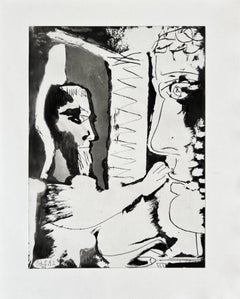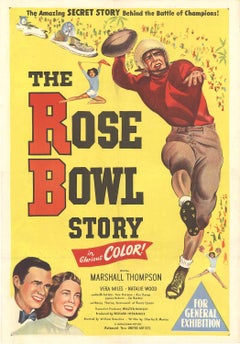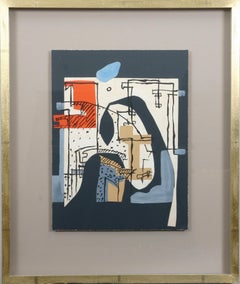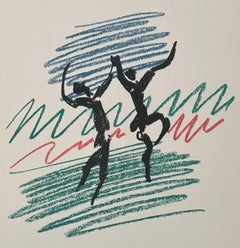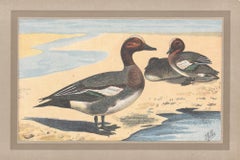Mid-20th Century More Prints
to
229
601
468
348
139
97
Overall Width
to
Overall Height
to
617
273
181
59
42
27
26
17
5
4
4
4
182
130
50
47
39
244
507
4,400
3,005
27
56
71
116
229
346
781
1,023
574
372
179
1,311
314
21
89
60
54
53
30
30
28
27
24
16
13
13
8
8
7
6
5
5
5
4
1,084
220
85
77
64
156
454
911
647
Period: Mid-20th Century
La Ruse de Dorcon, from Daphnis et Chloé
By Marc Chagall
Located in OPOLE, PL
This work will be exhibited at Art on Paper NYC, September 4–7, 2025.
–-
Marc Chagall (1887-1985) - La Ruse de Dorcon, from Daphnis et Chloé
Lithograph from 1961.
The edition of...
Category
Symbolist Mid-20th Century More Prints
Materials
Lithograph
$14,350 Sale Price
20% Off
Escultor y escultura
Located in OPOLE, PL
Pablo Picasso (1881-1973) - Escultor y escultura
Etching from 1965.
Edition of 255.
Dimensions of work: 48 x 38 cm.
Imprimée à Mougins.
Référence : Bloch 1187; Baer 1156.
The w...
Category
Modern Mid-20th Century More Prints
Materials
Lithograph
$1,435 Sale Price
20% Off
Original "The Rose Bowl Story" vintage Football movie poster US 1 sheet
Located in Spokane, WA
Original ROSE BOWL STORY authentic 1952 vintage movie poster. Archival linen-backed vintage theater used film poster. Very fine condition, ready to frame.
Original story and screenplay by Charles R. Marion.
Actors: Marshall Thomas; Vera Miles; Natalie Wood; Keith Larsen; Thom Harmon; Ann Doran; James Dobson; Jim Backus; Clarence Kolb; Barbara Woodell; Bill Welsh; Jean Andren; Gertrude Astor; Lela Bliss; Herbert Brackett; Oran Breeland; Paul Bryar; Willam Cabanne; Richard...
Category
American Modern Mid-20th Century More Prints
Materials
Offset
$958 Sale Price
20% Off
Le Corbusier: "Le Poème de L'Angle Droit". Original lithograph.
By Le Corbusier
Located in Richmond, GB
Charles-Éduard Jeanneret, known as Le Corbusier, was a Swiss architect and designer who is generally regarded as a key figure in the development of modern architecture, his work bein...
Category
Modern Mid-20th Century More Prints
Materials
Lithograph
La Danse, frontispiece from Picasso Lithographe III
Located in Washington, DC
Artist: Pablo Picasso
Title: La Danse (frontispiece)
Portfolio: Picasso Lithographe III
Medium: Transfer lithograph printed in colors
Date: 1956
Edition: 3000
Frame Size: 19 1/2" x 1...
Category
Modern Mid-20th Century More Prints
Materials
Lithograph
Eurasian Wigeon, French antique bird duck art illustration print
By P. Mahler
Located in Melbourne, Victoria
'Canard Siffleur'
(Eurasian Wigeon)
French chromolithograph, published in 1931. Printed title lower right of sheet. Plate number top right. From a French series of illustrations of...
Category
Art Deco Mid-20th Century More Prints
Materials
Lithograph
And in those dayes, when Moses was growen... - The Exodus
By Marc Chagall
Located in OPOLE, PL
This work will be exhibited at Art on Paper NYC, September 4–7, 2025.
–-
Marc Chagall (1887-1985) - And in those dayes, when Moses was growen, he went foorth unto his brethren, and...
Category
Symbolist Mid-20th Century More Prints
Materials
Lithograph
Le Corbusier: "Le Poème de L'Angle Droit". Original lithograph.
By Le Corbusier
Located in Richmond, GB
Charles-Éduard Jeanneret, known as Le Corbusier, was a Swiss architect and designer who is generally regarded as a key figure in the development of modern architecture, his work bein...
Category
Modern Mid-20th Century More Prints
Materials
Lithograph
Original "The Joe Louis Story", 1953 vintage movie poster
Located in Spokane, WA
Original “The Joe Louis Story” vintage movie poster (United Artists, 1953). One Sheet (27" X 41"). Sports. Archival linen backed.
Starring: Coley Wallace, Hilda Simms, Paul Stewart, James Edwards, John Marley, Dots Johnson, Evelyn Ellis, Carl 'Rocky' Latimer, John Marriott, Ike Jones, P. Jay Sidney, Royal Beal, Ruby Goldstein, Max Baer...
Category
American Realist Mid-20th Century More Prints
Materials
Offset
$679 Sale Price
20% Off
Jean Cocteau - Bulls - Original Lithograph
By Jean Cocteau
Located in Collonge Bellerive, Geneve, CH
Original Lithograph by Jean Cocteau
Title: Taureaux
Signed in the plate
Dimensions: 40 x 30 cm
Edition: 200
Luxury print edition from the portfolio of Trinckvel
1965
Jean Cocteau
W...
Category
Modern Mid-20th Century More Prints
Materials
Lithograph
Campagne Grecque (Greek Country) by Charles Lapicque - signed color lithograph
Located in New York, NY
This beautiful original lithograph depicting a Greek landscape by Charles Lapicque was printed in Paris at the Atelier Mourlot in 1964. The artist produced some of his first landscap...
Category
Modern Mid-20th Century More Prints
Materials
Lithograph
Original GREECE - Apollo - Olympia vintage 1956 first printing vintage poster
Located in Spokane, WA
Original travel poster: GREECE - OLYMPIA APOLLO, original vintage European travel poster. Size 23 3/8" x 31 3/8". Archival linen backed in very good condition; ready to frame. ...
Category
American Modern Mid-20th Century More Prints
Materials
Lithograph
La Mère et les Enfants
Located in New York, NY
Signed by Picasso in pencil lower left. Numbered 32/50 in pencil lower right.
Catalogue raisonne references: Bloch 739; Mourlot 239; Reuße 625.
Framed print. Framed dimensions ...
Category
Cubist Mid-20th Century More Prints
Materials
Lithograph
8 Mortal Sins Suite
Located in Hollywood, FL
ARTIST: Salvador Dali
TITLE: 8 Mortal Sins Suite
Anger
Avarice
Dalinean
Envy
Gluttony
Lust
Pride
Sloth
MEDIUM: 8 Etchings
SIGNED: Each piece is Hand Signed
PUBLISHER: Jean Schne...
Category
Surrealist Mid-20th Century More Prints
Materials
Etching
Original LOTERIE NATIONALE des PARFUMS vintage French poster lithograph
Located in Spokane, WA
LOTERIE NATIONALE des PARFUMS. Original vintage French poster, 1939 lithograph. Professional acid-free archival linen-backed, fine condition. Read...
Category
Art Deco Mid-20th Century More Prints
Materials
Lithograph
Original Buy Bonds Every Payday vintage World War 2 vintage poster
Located in Spokane, WA
Original World War 2 vintage poster: YOU CAN'T AFFORD TO MISS EITHER! BUY BONDS EVERY PAYDAY. Linen-backed, fine condition, ready to frame. Great ...
Category
American Realist Mid-20th Century More Prints
Materials
Offset
$2,280 Sale Price
20% Off
Jean Cocteau - Bulls - Original Lithograph
By Jean Cocteau
Located in Collonge Bellerive, Geneve, CH
Original Lithograph by Jean Cocteau
Title: Taureaux
Signed in the plate
Dimensions: 40 x 30 cm
Edition: 200
Luxury print edition from the portfolio of Trinckvel
1965
From the last po...
Category
Modern Mid-20th Century More Prints
Materials
Lithograph
Décoration - Masques
Located in OPOLE, PL
Henri Matisse (1869-1954) - Décoration - Masques
Lithograph from 1958.
Dimensions of work: 96.5 x 35.5 cm.
Plate signed.
Publisher: Tériade, Paris.
Each copy of this Lithograph ...
Category
Surrealist Mid-20th Century More Prints
Materials
Lithograph
$717 Sale Price
40% Off
New York City Plaza (Plaza Fountain)
Located in Hollywood, FL
ARTIST: Salvador Dali
TITLE: New York City Plaza (Plaza Fountain)
MEDIUM: Etching
SIGNED: Hand Signed
EDITION NUMBER: 101/125
MEASUREMENTS: 30" x 22"
YEAR: 1964
FRAMED: No
C...
Category
Surrealist Mid-20th Century More Prints
Materials
Etching
Original Radio Radiola vintage French poster with parrot
Located in Spokane, WA
Original Radio Radiola vintage French antique poster. Archival linen-backed and in very good condition. Bright and vibrant. Artist: Rene Ravo....
Category
American Modern Mid-20th Century More Prints
Materials
Lithograph
Faune Dévoilant une Dormeuse
Located in Berlin, DE
Signed in pencil lower right 'Picasso'. Plate 27 of the 'Suite Vollard'. One of 250 impressions. Paris, Édition Vollard, 1939. On Montval-wove paper watermarked 'Vollard'. One of th...
Category
Mid-20th Century More Prints
Materials
Aquatint, Black and White
Untitled (Litho #7)
Located in New York, NY
A very good impression of this scarce and early lithograph on Arches. Edition of 50. Printed at Hollander's Workshop, Inc., New York, with the blind stamp lower right.
Provenance: ...
Category
Abstract Expressionist Mid-20th Century More Prints
Materials
Lithograph
Cirque
By Marc Chagall
Located in OPOLE, PL
Marc Chagall (1887-1985) - Cirque
Lithograph from 1967.
The edition of 250 on Arches paper.
Dimensions of work: 42 x 32.5 cm.
Publisher: Tériade, Paris.
Reference: Mourlot 487, ...
Category
Symbolist Mid-20th Century More Prints
Materials
Lithograph
$1,865
Adveniat Regnuum Tuum - Lithograph Attr. to S. Dali - 1964
Located in Roma, IT
Adveniat Regnuum Tuum is an original lithograph by Salvador Dalí (1904 – 1989), from the volume "Pater Noster" published by Rizzoli Editore, Milan, 1964.
Signed and dated "1964" on plate on the lower left margin. In excellent conditions.
Reference: R. Michel, L. W. Löpsinger, Dalì, Catalogue Raisonné of Prints II, Lithographs and Wood engravings, 1956-1980, p. 180, n. 1599.
Pater Noster is a beautiful artists' book illustrated by the oldest and mystic Salvador Dalí. Nine colored plates protected by Japanese paper represent the verses of the Lord's Prayer. The pages of a 14th-century missal reproduce a Pater Noster in Gregorian chant...
Category
Surrealist Mid-20th Century More Prints
Materials
Lithograph
L'homme au mouton
Located in OPOLE, PL
Pablo Picasso (1881-1973) - L'homme au mouton
Lithograph from 1967.
The edition of 223/500 on Auvergne Richard de Bas paper.
With two watermarks - one of the paper, second of the ...
Category
Modern Mid-20th Century More Prints
Materials
Lithograph
Le Démon ailé
Located in OPOLE, PL
Salvador Dali (1904-1989) - Le Démon ailé
Etching from 1969.
86/145 on Japan paper.
Dimensions of work: 31 x 23.5 cm.
Hand signed.
Publisher: Graphik Europa Anstalt.
Reference:...
Category
Modern Mid-20th Century More Prints
Materials
Drypoint, Etching
Untitled - Etching by H. Bellmer - Mid-20th Century
By Hans Bellmer
Located in Roma, IT
Untitled is a contemporary artwork realized by Hans Bellmer in the mid-20th Century.
Colored etching
Hand signed and numbered on the lower margin.
Edition of 54/150
Category
Surrealist Mid-20th Century More Prints
Materials
Etching
Bullfighting Poster with Manolete - Valencia, 31 July 1941
Located in London, GB
Carlos Ruano Llopis (1878-1950)
Original Vintage Bullfighting Poster
March 1953
107cm x 53cm
Carlos Ruano Llopis was born in 1878 in Orba, Spain ...
Category
Other Art Style Mid-20th Century More Prints
Materials
Lithograph
Apparition of Christ - Woodcut print - 1963
Located in Roma, IT
Apparition of Christ - Paradise 14 is a woodcut print realized in 1963 for a series illustrating the Medieval poem of the "Divine Comedy" by Dante Alighieri.
Good conditions.
Limi...
Category
Surrealist Mid-20th Century More Prints
Materials
Woodcut
Grapin fait le bon vin original French vintage poster
By Leon Dupin
Located in Spokane, WA
Original vintage 1933 poster: Graphin. The silhouette of the man is sitting on a casket of wine with a big bottle of wine resting on the ground in front ...
Category
Art Deco Mid-20th Century More Prints
Materials
Lithograph
Pablo Picasso (after) Helene Chez Archimede - Wood Engraving
Located in Collonge Bellerive, Geneve, CH
Pablo Picasso (after)
Helene Chez Archimede
Medium: engraved on wood by Georges Aubert
Dimensions: 44 x 33 cm
Portfolio: Helen Chez Archimede
Year: 1955
Edition: 240 (Here it is on...
Category
Modern Mid-20th Century More Prints
Materials
Wood, Archival Paper, Engraving
Mod Abstract Expressionist Modernist Lithograph Edward Avedisian Color Field Art
Located in Surfside, FL
Edward Avedisian (1936-2007)
Green Gold, 1969
Lithograph in color on Arches wove paper.
Hand signed, dated and numbered in pencil.
Edition 100
Dimensions:
22.25 inches X 30.25 inch...
Category
Abstract Expressionist Mid-20th Century More Prints
Materials
Lithograph
Bullfighting Poster - Castellón 13 March 1944
Located in London, GB
Juan Reus (1912-2003)
Original Vintage Bullfighting Poster
March 1944
107cm x 53cm
Juan Reus was born in 1912 in Valencia, where he became a well-known pain...
Category
Other Art Style Mid-20th Century More Prints
Materials
Lithograph
Carnets intimes de Braque II
Located in OPOLE, PL
Georges Braque (1882-1963) - Carnets intimes de Braque II
Lithograph from 1955.
Dimensions of work: 35 x 26 cm
Publisher: Tériade, Paris.
The work is in Excellent condition.
Fas...
Category
Surrealist Mid-20th Century More Prints
Materials
Lithograph
Woman with Monkey
Located in OPOLE, PL
Pablo Picasso (1881-1973) - Woman with Monkey
Lithograph from 1954.
Dimensions of work: 35.5 x 26.5 cm
Publisher: Tériade, Paris.
The work is in Excellent condition.
Fast and se...
Category
Modern Mid-20th Century More Prints
Materials
Lithograph
Brent (Brant) Goose, French antique natural history bird art illustration print
By P. Mahler
Located in Melbourne, Victoria
'Bernache Cravant'
(Brent Goose)
French chromolithograph, published in 1931. Printed title lower right of sheet. Plate number top right. From a French series of illustrations of bi...
Category
Art Deco Mid-20th Century More Prints
Materials
Lithograph
Homme couché et femme assise
Located in OPOLE, PL
Pablo Picasso (1881-1973) - Homme couché et femme assise
Lithograph from 1967.
The edition of 29/500 on Auvergne Richard de Bas paper.
With two watermarks - one of the paper, seco...
Category
Modern Mid-20th Century More Prints
Materials
Lithograph
$2,391 Sale Price
20% Off
Arlequin
Located in OPOLE, PL
Pablo Picasso (1881-1973) - Arlequin
Lithograph from 1962.
An unnumbered copy from a limited edition of 260.
Dimensions of work: 48.5 x 36 cm
Publisher: Leda, Éditions d'Art, Par...
Category
Modern Mid-20th Century More Prints
Materials
Lithograph
Original "Less Dangerous than Careless Talk" vintage World War Two poster
Located in Spokane, WA
Original “Less Dangerous than Careless Talk” vintage World War Two poster. Archivally linen=backed in fine condition A-, ready to frame. Bright colors and excellent detail. Very clean. The images shown are the exact poster you will receive. A-
"Less Dangerous than Careless Talk" is a World War II propaganda poster designed to caution against the dangers of loose lips...
Category
American Realist Mid-20th Century More Prints
Materials
Offset
Original "The Chateaux of the Loire, Go by Train" vintage poster
Located in Spokane, WA
Original vintage poster: The Chateaux of the Loire, Go By Train, artist J. Jacquelin, size: 24" x 39", year: 1956. Original vintage European travel poster...
Category
American Impressionist Mid-20th Century More Prints
Materials
Lithograph
$718 Sale Price
20% Off
Joan Miro (Plate 7)
By Joan Miró
Located in Washington, DC
Artist: Joan Miro
Title: Joan Miro (Plate 7)
Portfolio: Joan Miro
Medium: Lithograph
Date: 1956
Edition: Unnumbered
Frame Size: 15 1/4" x 21 1/2"
Sheet Size: 9" x 15"
Signature: Unsi...
Category
Modern Mid-20th Century More Prints
Materials
Lithograph
Salvador Dali, "Reverence de Grosillier (Gooseberry), " hand signed
Located in Chatsworth, CA
This piece was created in 1969 by Salvador Dali, it is a photolithograph of a original gouache painted on printed illustrations with original engraving. This piece is hand signed and...
Category
Surrealist Mid-20th Century More Prints
Materials
Lithograph
Original "Food is a Weapon, Don't Waste It!" vintage World War Two poster
Located in Spokane, WA
Original WWII poster: Food Is a Weapon Don't Waste It!. Professional acid-free archival linen backed and ready to frame. Fine condition.
Food is a weapon. Don't waste it! Buy wi...
Category
American Realist Mid-20th Century More Prints
Materials
Offset
German Aircraft, original vintage Second World War poster
Located in London, GB
German Aircraft
Original vintage Second World War poster
Lithograph
51 x 71 cm
c.1941-1944
This original vintage poster, published in 1941, depicts a series of German aircraft,...
Category
Realist Mid-20th Century More Prints
Materials
Lithograph
Alhambra XII
Located in New York, NY
Antonio Frasconi created the color woodcut entitled “Alhambra XII” in 1963. This piece is signed titled, and dated in pencil. The edition is 12, and paper size is 18 x 24 inches. “...
Category
American Modern Mid-20th Century More Prints
Materials
Woodcut
Nude
Located in New York, NY
Pencil signed and numbered 32/200 in pencil on lower edge. Published by Original Editions, New York. From 11 Pop Artists, Volume II.
A spectacular, colorful image, and a Pop Art ma...
Category
Pop Art Mid-20th Century More Prints
Materials
Screen, Color
$8,000
Giuseppe Capogrossi - Stencil
Located in Collonge Bellerive, Geneve, CH
Giuseppe Capogrossi - Stencil
1958
Dimensions: 32 x 25 cm
Edition: G. di San Lazzaro.
Giuseppe Capogrossi
B. 1900, ROME; D. 1972, ROME
Giuseppe C...
Category
Abstract Expressionist Mid-20th Century More Prints
Materials
Lithograph
Original "Point Bleu Radio" vintage poster, faithful reflection of the world
Located in Spokane, WA
Original lithograph: POINT BLEU RADIO. Artist: Pierre. Baudouin (1921 - 1971). Size is 31" x 47". Archival linen backed and ready to frame.
Cleaned and restored rare original French antique...
Category
American Modern Mid-20th Century More Prints
Materials
Lithograph
Obra inèdita recent
By Joan Miró
Located in New York, NY
A very good impression of this color lithograph. Initialed and numbered 73/100 in pencil by Miro. Published by Sala Gaspar, Barcelona. From the same-titled suite.
Category
Modern Mid-20th Century More Prints
Materials
Color, Lithograph
Appolon
Located in OPOLE, PL
Henri Matisse (1869-1954) - Appolon
Lithograph from 1958.
Dimensions of work: 52.5 x 35.5 cm.
Plate signed.
Publisher: Tériade, Paris.
Each copy of this Lithograph was originall...
Category
Surrealist Mid-20th Century More Prints
Materials
Lithograph
$717 Sale Price
40% Off
Original 'Ghost of Zorro' vintage 1949 movie poster US 1-sheet
Located in Spokane, WA
Original ‘Ghost of Zorro’ vintage movie poster. 1949. Museum archival mounted on acid-free archival linen. Original fold marks touched up but could use more touch-up on the fol...
Category
American Modern Mid-20th Century More Prints
Materials
Offset
$840 Sale Price
30% Off
Freedom From Want - The Four Freedoms
Located in New York, NY
NORMAN ROCKWELL (1894-1978) - The Freedom from want - [from the series THE FOUR FREEDOMS.] 1943.
40x28 1/4inches, 101 1/2x71 3/4 cm.
World War II poster
U.S. Government Printing Office...
Category
American Modern Mid-20th Century More Prints
Materials
Paper
Bullfighting Poster - Granada, 9 June 1947
Located in London, GB
Carlos Ruano Llopis (1878-1950)
Original Vintage Bullfighting Poster
June 1947
107cm x 53cm
Carlos Ruano Llopis was born in 1878 in Orba, Spain w...
Category
Other Art Style Mid-20th Century More Prints
Materials
Lithograph
The Man with the Bird
Located in OPOLE, PL
Pablo Picasso (1881-1973) - The Man with the Bird
Phototype and pochoir from 1962.
From the edition of 1,000 copies, this example is number 334, as noted in the colophon.
Dimensio...
Category
Modern Mid-20th Century More Prints
Materials
Stencil
Les Trois mousquetaires, Series 347, Plate 91
Located in OPOLE, PL
Pablo Picasso (1881-1973) - Les Trois mousquetaires, Series 347, Plate 91
Etching and aquatint from 1968.
The edition of 36/50.
Dimensions of work: 28.2 x 33.5 cm.
Hand signed.
...
Category
Modern Mid-20th Century More Prints
Materials
Etching, Aquatint
LOVE /// Robert Indiana Typography Pop Art Screenprint Black and White Print Art
Located in Saint Augustine, FL
Artist: (after) Robert Indiana (American, 1928-2018)
Title: "LOVE"
Portfolio: Banner, Multiples Calendar for 1970
*Issued unsigned
Year: 1969
Medium: Original Screenprint on smooth w...
Category
Pop Art Mid-20th Century More Prints
Materials
Screen
Original 1944 "... because somebody talked!" vintage poster
Located in Spokane, WA
Original vintage poster: …BECAUSE SOMEBODY TALKED. Original World War II (2) linen-backed 1944 poster.
Artist: Wesley Heyman. Size 20" x 28" Linen backed. Excellent condition. Antique poster ready to frame. Original issued U. S. Government fold marks touched up during linen backing. This is not considered a defect on World War II posters.
Because Someone Talked portrays a cocker resting his head on his master's scarf. The gold star flag behind his head reveals that his master has been killed in action. The flag was awarded to mothers who lost sons.
Published by the United States Government Printing Office
Interpretation This poster, issued by the United States government during World War II, is a warning to citizens that discussing troop movements, or other military information that might be useful to the enemy, could have serious consequences. The Service Flag...
Category
American Realist Mid-20th Century More Prints
Materials
Offset
Jacqueline en espagnole
Located in OPOLE, PL
Pablo Picasso (1881-1973) - Jacqueline en espagnole
Lithograph from 1967.
The edition of 223/500 on Auvergne Richard de Bas paper.
With two watermarks - one of the paper, second o...
Category
Modern Mid-20th Century More Prints
Materials
Lithograph
The Clown with Flowers
By Marc Chagall
Located in OPOLE, PL
Marc Chagall (1887-1985) - The Clown with Flowers
Original Lithograph from 1960.
Dimensions of work: 32 x 24 cm.
Publisher: Maeght Éditeur, Paris.
The work is in Excellent condit...
Category
Modern Mid-20th Century More Prints
Materials
Lithograph
He Repeated the Letters of the Alphabet
By Corita Kent
Located in Missouri, MO
Sister Mary Corita Kent (American, 1918-1986)
He Repeated the Letters of the Alphabet...
Color Screenprint
22.5 x 38.75 inches
Signed Lower Right
Sister Mary Corita Kent, once the n...
Category
American Modern Mid-20th Century More Prints
Materials
Color, Screen
Recently Viewed
View AllMore Ways To Browse
Villard L
Vintage Boombox
Vintage Boxing Knockouts
Vintage Dior Bag Men
Vintage Fairground Posters
Vintage Horse Logging
Vives Maristany
Walford Painting
Walt Horton
Whitney Birch
Willi Bauer Oil Painting
William Beattie Brown
William Callow
William Krug
William Otto Emerson
Wyland Paintings
Yorkshire Terrier Oil Painting
Yvette Mimieux

